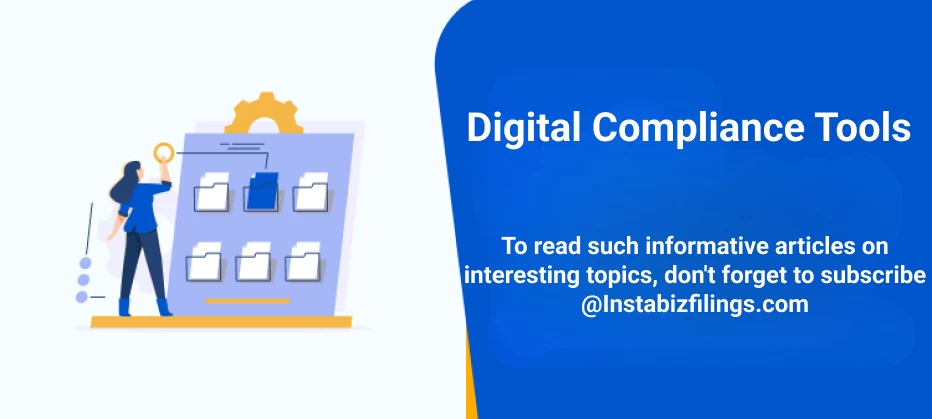
Digital Compliance Tools
November 7, 2025 by Team Instabizfilings
What are digital compliance tools?
Digital compliance platforms are applications or software that enable organisations to address their regulatory, legal, risk-governance requirements in an automated, data-driven fashion as opposed to exclusive manual, paper-based processes. They generally support:
-
regulatory change monitoring,
-
control and policy tracking,
-
audit, reporting and evidence gathering,
-
risk assessment (third-party/vendor risk included),
-
data-governance (privacy, cyber security),
-
and sometimes the integration of compliance within operations or product capabilities.
With regulation becoming increasingly complex (cyber legislations, data protection, ESG, governance of AI, supply chain, etc.), digital solutions play a crucial role in achieving scale, timeliness, accuracy, and visibility.
Why they matter in 2025
There are several reasons why compliance tools in the digital environment are more critical this year:
-
Regulatory complexity and speed : Recent regulations (e.g., in the EU: Digital Operational Resilience Act (DORA), the EU AI Act, and data-protection changes) place additional obligations on organisations.
-
Cybersecurity/data risk ramp-up : With hybrid work, cloud, IoT, supply-chain digitalisation, the perimeter for compliance is wider.
-
Need for real-time/ongoing monitoring : Annual audits are not sufficient; organisations require ongoing control monitoring, real-time warnings and dashboards.
-
Third-party / supply-chain risk : Organisations depend significantly on vendors, outsourcing, cloud providers, and regulators are taking an interest in this.
-
AI & automation becoming ubiquitous : Both as a tool of compliance and as something that compliance will need to regulate (AI usage itself being a compliance risk).
-
Integration of governance, risk and compliance (GRC) : into operations and strategy as opposed to being separate functions.
Combined, these make digital compliance tools not only "nice to have" but more and more business-critical.
Key categories/types of digital compliance tools
Here are the major types of tools you’ll find. Many platforms combine several of these capabilities.
|
Category |
What they do |
Why useful |
|
RegTech / GRC platforms |
Governance, Risk & Compliance platforms that allow you to map policies, controls, risks, audit trails, dashboards. |
Provide a central “single source of truth” for compliance. |
|
Automation / workflow tools |
Automate tasks like risk assessments, policy attestations, incident logging, evidence collection. |
Reduces manual labour, speeds up processes, improves consistency. |
|
Real-time monitoring & analytics tools |
Monitor control effectiveness, use analytics/predictive modelling to flag non-conformances or anomalies. |
Enables proactive rather than reactive compliance. |
|
Third-party / vendor risk management tools |
Map and monitor vendor risk; collect evidence, certificates, audit reports, track concentration. |
Third-party risk is a major compliance weak point. |
|
Data governance/data privacy tools |
Manage data classification, consent, data-subject requests, privacy controls, and cross-border data flows. |
Critical with GDPR/CCPA/equivalents globally. |
|
Cybersecurity compliance tools |
Zero trust architecture, continuous identity/endpoint monitoring, audit logging & forensic readiness. |
Many regulators expect cybersecurity compliance as part of overall compliance. |
|
Industry-specific compliance tools |
Tools tailored for sectors: fintech (KYC/AML), healthcare (HIPAA), manufacturing (safety audits), etc. |
Customised for regulatory nuance & industry specifics. |
Core features & capabilities of good tools
When evaluating a digital compliance tool, you’ll want to check for features such as:
-
Policy & control mapping: ability to map regulations → policies → controls → responsibilities.
-
Automation of workflows: notifications, escalations, attestations, and evidence capture.
-
Real-time dashboards and KPIs: e.g., % of controls compliant, time to remediate violations, vendor risk levels.
-
Integration and connectivity: with HR systems, IAM (identity & access management), cloud platforms, ticketing, vendor systems.
-
Analytics/predictive functionality: anomaly detection, trend analysis, risk scoring.
-
Third-party management: vendor inventory, criticality classification, evidence repository.
-
Data governance/control: privacy management, consent tracking, data lineage, cross-border flows.
-
Audit trail & evidence management: capacity to gather, hold and report evidence for regulatory inspection.
-
Scalability, cloud-capability and mobility: support for distributed operations, mobile inspections/field audits.
-
Governance/responsibility management: ability to correlate executive oversight, board reporting, roles & responsibilities.
Emerging trends in 2025
Some of the most important trends in digital compliance tools in 2025 are:
-
AI & ML in compliance : Machine learning applied to anomaly detection, automated document processing, predictive risk modelling.
-
Continuous control monitoring (CCM) : Controls continuously monitored (not only at audit time) through integrated data feeds from systems (IAM, DLP, HRIS etc.).
-
Supply-chain/third-party risk intensifying : Suppliers and their suppliers (4th party) pose a significant risk; tools centred here.
-
Cybersecurity compliance converging with operational compliance : e.g., "digital operational resilience" models, zero-trust becoming compliance requirements.
-
Data-privacy/data-governance going mainstream : Especially since AI will consume increasingly more data, new data regulations emerge in increasingly more jurisdictions.
-
ESG / sustainability compliance : Firms being subject to ESG and sustainability targets as part of compliance, rather than a "nice to have".
-
Mobile-first / remote field audits : As business becomes more decentralized, technology underpinning mobile inspections, evidence collection in the field.
-
Board/leadership accountability : Compliance is no longer solely for the compliance team; boards and executives are increasingly held accountable.
How to select & implement digital compliance tools
Here's a top-level guide for organisations that want to implement or upgrade compliance tools.
- Step 1: Evaluate current state
- Plot your current compliance landscape: policies, controls, responsibilities, tools, gaps.
- Determine: the regulatory requirements in your jurisdiction(s) + industry.
- Evaluate risk areas: data privacy, cyber security, third-party risk, operational resilience, ESG etc.
- Audit existing tool landscape: spreadsheets, legacy systems, and manual workflows.
- Step 2: Establish requirements
- Establish key capabilities required: e.g., vendor risk module, real-time monitoring, data governance, workflow automation.
- Identify integration points: what needs to integrate? HR, IAM, cloud platform, ticketing, vendor platform, audit logs.
- Identify scale & mobility requirements: remote/field staff, global operations.
- Identify compliance/assurance reporting requirements: dashboards, KPIs, evidence repository.
- Think future-proofing: AI/analytics readiness, support for future regulation, supplier ecosystem.
- Step 3: Vendor/tool selection
- Verify functional fit: coverage of your essential requirements.
- Verify technical fit: architecture (cloud/native?), integration APIs, security, access controls.
- Verify scalability & flexibility: can it grow with you?
- Verify vendor: track record & industry references.
- Verify cost model: licensing, deployment, training, maintenance.
- Verify implementation: support, training, and change-management capabilities.
- Step 4: Implementation
- Define governance: who within the organisation drives compliance tool adoption (usually a combination of compliance, IT, risk, vendor management).
- Plan phased rollout: begin with high-value modules (e.g., vendor risk or data governance) and phase out.
- Modify processes: digital tools may need process re-engineering (workflow changes, roles, training).
- Integrate data sources: connect current systems to supply data into the compliance tool (IAM, HR, vendor systems, audit logs).
- Change management & training: get users to use the tool and use it correctly, not as an add-on.
- Monitor, measure & improve: monitor KPIs, dashboards, user adoption, control effectiveness; iterate.
- Step 5: Ongoing operations & continuous improvement
- Modify tool configurations/processes when regulation or business changes.
- Utilise the analytics/predictive capabilities to detect rising risks and modify controls.
- Be audit-ready: keep evidence, logs, dashboards.
- Periodically review vendor/tool performance and upgrade where necessary.
- Establish a culture of compliance: tools are facilitators, but people/processes are important.
Specific use-cases across industries
-
Fintech & financial services: AML/KYC automation, transaction monitoring, sanctions screening, crypto hybrid compliance.
-
Manufacturing/supply-chain: Environmental regulatory (e.g., maritime sector example via blockchain) for operational resilience.
-
Small businesses / SMEs: Mobile first audit/inspection tools, vertical-specific templates (e.g., agriculture, logistics) to minimise overhead.
-
Technology / SaaS firms: Governance of data for AI systems, management of consent, third-party vendor risk (cloud providers).
-
Global businesses / multi-jurisdictional: Require single tool/framework for many geographies, regulatory regimes, and distributed teams.
Key challenges & pitfalls
-
Implementation without change in process: purchasing a tool but retaining manual process = limited benefit.
-
Data integration problems: tools are data-dependent; absent feeds or compromised data quality compromise effectiveness.
-
Over-engineering: opting for a tool with too many features and over-embedding the organisation can result in weak take-up.
-
Lack of buy-in from leadership: executive sponsorship is required for compliance and explicit accountability (board level).
-
Vendor/third-party risk neglect: Tools might be inward-facing but ignore the wider ecosystem.
-
Ethical/AI risk: With tools integrating AI, organisations need to address transparency, model governance, bias, and regulatory oversight.
What’s ahead: future of digital compliance tools
Glancing a little into the future, here are what I perceive as emerging / near-term developments:
-
Deeper AI agents in compliance: autonomous agents that watch, evaluate controls, escalate, perhaps even remediate.
-
Compliance-as-code & "Infrastructure as code" for compliance: policy embedded in pipelines, version-controlled, enforced automatically.
-
X-RegTech convergence: compliance tools integrating cyber, operational risk, ESG and financial risk into combined platforms.
-
More real-time/continuous auditing: controls are watched in real time as opposed to periodic review.
-
Blockchain / immutable: logging for audit trails & supply-chain transparency.
-
More global regulation: alignment/harmonisation, but also more digital enforcement (via data extraction, APIs) so tools must be able to support this.
-
Embedded compliance in products: Compliance is a product feature (particularly in fintech/SaaS) as opposed to a back-office function.
Summary & take-aways
-
Digital compliance tools are no longer a luxury; they're at the heart of risk management, regulation, and business continuity.
-
The landscape of tools is wide: GRC platforms, automation, monitoring, vendor-risk, data governance, and cybersecurity compliance.
-
Successful tools integrate workflow automation, real-time monitoring, analytics, integration, evidence management.
-
2025 focuses on AI, continuous controls, vendor risk, data privacy, ESG, and accountability of leadership.
-
Successful selection and implementation call for a clear strategy, process alignment, integration of data, change management, and governance.
-
The future holds greater automation, agents, "compliance‐infrastructure", and increased integration of compliance into business processes.
Disclaimer
The information provided in this blog is purely for general informational purposes only. While every effort has been made to ensure the accuracy, reliability and completeness of the content presented, we make no representations or warranties of any kind, express or implied, for the same.
We expressly disclaim any and all liability for any loss, damage or injury arising from or in connection with the use of or reliance on this information. This includes, but is not limited to, any direct, indirect, incidental, consequential or punitive damage.
Further, we reserve the right to make changes to the content at any time without prior notice. For specific advice tailored to your situation, we request you to get in touch with us.


